Create a surface with Advanced Sweep
The basic Sweep command is available in the Freeform menu. Its control options (by Spine, by Face, and Constant) are also available in the Advanced Sweep command described below; seeSweep a part for details on these options.
The Surfacing module provides an Advanced Sweep function that offers three further control modes, the option to create face parts rather than solids, and the possibility to use any collection of edges (in one plane) as the sweep profile.
The Advanced Sweep control modes are as follows:
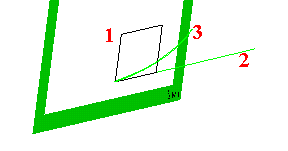
1. a closed profile on a workplane
2. the spine curve
3. the guiding ("birail") curve
To create a surface with Advanced Sweep,
1. Activate the Surfacing module.
a. Click > . The Modules dialog box opens.
b. On the Modules pane, click Surfacing under Licensed.
2. Click Surfacing and then, in the Advanced Surfacing group, click  Advanced Sweep. The Advanced Sweep and Select dialog boxes open.
Advanced Sweep. The Advanced Sweep and Select dialog boxes open.
 Advanced Sweep. The Advanced Sweep and Select dialog boxes open.
Advanced Sweep. The Advanced Sweep and Select dialog boxes open.3. If necessary, enter a name for the part in the Part data entry field. The Spine option becomes active and the Select tool opens, waiting for you to select the edges defining the sweep spine.
4. Click the edges comprising the spine.
5. Click End in the Select tool. The Select tool closes.
6. The profile to sweep is selected automatically; if necessary, you can change this selection in one of the following ways:
◦ Click WP and select a workplane containing an open or closed profile.
◦ Click Profile to open the Select tool, and click 2D or 3D edges (all in single plane) that define an open or closed profile. Click End to complete the edge selection.
7. When sweeping closed profiles, to create a tube face part by omitting the top and bottom faces of the swept volume, click top+bottom off. (This option is not available when sweeping open profiles, as this always produces face parts.)
8. Select the sweep control mode. You can choose one of the following modes:
◦ by Spine: The default control mode. The normal of the profile will follow the spine during the sweep operation.
◦ by Face: The sweep path is described by an existing body edge adjacent to a face.
◦ Constant: The normal of the profile will not change its orientation during the sweep operation.
◦ Birail: The orientation and scaling of the sweep is taken from a guiding birail curve.
With this option, the scaling and orientation of the sweep operation is guided by a birail curve. The orientation at each point on the spine is given by the vector from the spine to the birail, and the distance between the profile and the birail determines the scaling factor.
For example, if the profile is a square, each cross section of the swept volume will be square, but not necessarily of the same edge length.
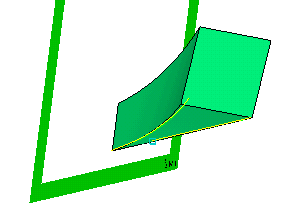
◦ Const. birail: Only the orientation is determined by the birail curve. The profile shape does not change as it is swept.
The constant birail option is similar to the (non-constant) birail described above, but only the orientation is determined by the birail curve. The profile shape does not change as it is swept. So if the profile is a square of edge length 10, each cross section of the swept volume will be a square of edge length 10.
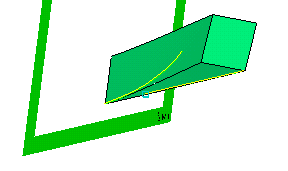
◦ Angle: The profile is turned about the spine during the sweep, until it reaches a final twist angle.
This option twists the profile along the spine up to a given angle. The angle is the turn angle of the profile at the endpoint on the spine.
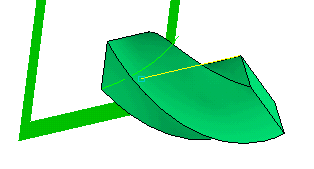
◦ Pref. Dir: The profile is oriented along the spine so that a constant angle is maintained between the profile's 2D x-axis and the given direction. The spine cannot be parallel to the specified direction at any point.
9. When you select Birail or Const. birail, the Select tool opens again: Now specify the edges that define the birail curve, and click End when you are finished.
10. When you select Angle, a new Angle data entry field appears in the menu; enter the final twist angle for the profile.
11. When you select Pref. Dir, a new field, Pref. Dir, appears; specify the direction for the sweep.
12. Click Preview to see a preview of the sweep.
13. Click  to complete the operation.
to complete the operation.
 to complete the operation.
to complete the operation.Options
In the illustrations above, closed profiles on a workplane are used in the sweep operations. You have the option to create a solid body or a sheet body (face part). Creating a face part omits the top and bottom faces of the sweep volume and results in a tube:
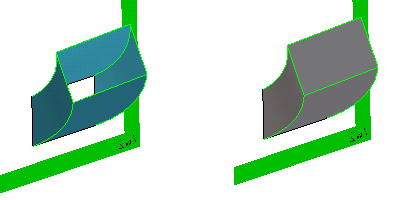
However, open profiles can also be used in a sweep operation. This will also result in a face part:

In addition to using a profile on a workplane, it is also possible to use as the sweep profile any collection of 2D and 3D edges that lie in a single plane.
Limitations
A birail curve must not intersect the spine.
The birail must not be too "short"; that is, a plane moved along the spine must always intersect the birail.
It is not recommended to make helices (along a straight line) with the Twist Angle option of Advanced Sweep. The data volume here is much larger than with the dedicated Helix command of the Freeform module.